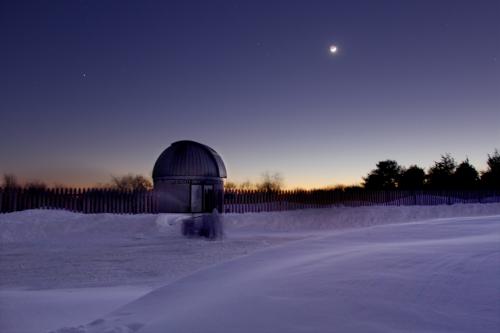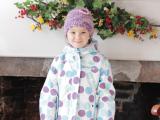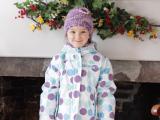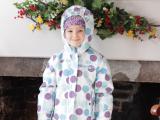Dressing for All-Night Winter Stargazing
As the New England late-autumn sets in, and with it, the cooler temps of winter, stargazing starts to sound a bit relentless and the idea becomes as remote as a sunny day at the beach. Though the cold temperatures and potentially snowy landscape can be a cause for thermal concern, proper winter attire applied in the correct layered order can make for remarkably warm and cozy happiness out under the stars.
First, a few things to keep in mind. Most observatories are not heated and need to keep the inside of the building the same temperature as outside. As sadistic as this sounds, it is necessary to avoid heat rising out of the observatory roof which will cause optical distortions that the telescope will further magnify. This is similar to what happens when looking over a bonfire at bright objects beyond. The telescope and equipment must also match the outside air temperature, otherwise heat will rise out of the telescope causing the same optical distortions. Telescopes outside the observatory are completely exposed to the elements and so are their observers. A steady 3-5mph wind will make a cold night feel absolutely frigid, and can totally wreak havoc on your ability to keep warm.
Growing up involved in winter sports and working full time as a ski instructor in my early 20's, I spent most winter nights exposed to bitterly cold mountain winter temperatures. I quickly learned how to keep the cold out and last the entire night safely warm. On the mountain, I often hear people state that dressing in layers will keep you warm on those cold winter nights. This statement is true, but only if understood and applied properly. Unfortunately, most weekend warriors, with this statement in mind, will just pack on several unnecessary layers of clothing which actually further restricts essential blood flow to extremities, blood flow that is already naturally subdued due to your body keeping blood around your vital organs. The idea is to keep as much heat as possible inside your clothing, resulting in blood naturally flowing to extremities.
To do this we need to dress in layers, overlapping layers. Every article of clothing worn should be loose fitting and overlap at the edges with adjoining, loose fitting articles. Proper overlapping of layers will allow for heat to rise into the next article, eventually making its way to the top of your head. If heat is allowed to escape at any joint section, then the enclosed body part will quickly and surely become cold. A common example of this error is tucking jeans or pants into your boots, which is a bad practice I often see visitors doing. Heat will rapidly rise out of your boot escaping into the atmosphere and your foot will most certainly become cold, quickly. By pulling your pants over the top of your boots, heat will rise from your boots into your pants instead of escaping into the outside air. This will keep an evenly heated zone and your foot will remain warm as rising heat will slow and stay in your boot long enough to maintain a steady temperature.
Now the fun part, getting dressed for an excellent night of winter stargazing. Items needed:
1: Socks that have thick soles but are otherwise thin (standard thickness). If your socks are of the thick woolly kind, your feet will be constricted in your boots and will become cold quickly. The socks should also be long enough to pull up over your calves to just below the knee. If you have athletic socks that are slightly tight (not constricting) around your calves and offer a little ankle support, this will cause friction on your lower legs as you walk , inspiring additional blood flow. I generally pick up a good pair of GI green army socks at a local Army Navy Surplus. The soles are thick, the rest is thin. They are comfortable and sturdy.
2: Long Johns (thermal underwear) and thermal shirt. You can substitute a long sleeve t-shirt, but thermal underwear pants are a necessity. Sweat pants will be too thick and bulky and will eventually result in constricting your legs. Remember, not too tight. These articles should be a comfortable fit.
3: Boot cut jeans. None of this sexy, too-tight-for-my-five-year-old nonsense. They may look great on you, but this is about function first – fashion second. The jeans should fit comfortably over your long johns.
4: A sweater, performance fleece, or or turtleneck. This item can be a little thick but not too bulky that it makes your jacket tight. This article should also have a collar on it (like a turtle neck or fleece with a zip). If you do not have any article with a sufficient collar, a scarf will suffice.
5: Jacket that will break the wind. Your jacket is essential though it does not have to be super heavy and thick. The most important part of this article is its ability to deflect wind. This layer should be loose fitting, as a tight jacket will just make you cold. The jacket should have sleeves that allow for easy overlapping of gloves comfortably. If the jacket has a hood with a faux fur lining (never wear real fur!!), you will be set.
6: Loose fitting gloves that deflect wind. Gloves are tricky as they need to have enough material to cover your wrists allowing your jacket sleeves to overlap significantly. If you are prone to cold fingers, mittens are your savior!
7: Hat, scarf (or Turtle Fur), and boots. Boots should be loose fitting and designed for snow, winter weather, and water proof / resistant. If your boots have a thin sole, this could result in cold feet as you will be standing on concrete and frozen ground. Thin fashionable boots will look hot, but will keep your feet cold.
Start with nothing on, that's right, get naked! Socks come first. Some good pointers with feet. First, keep toe nails nice and trimmed. Long toe nails will result in cold toes. Secondly, many people have feet prone to sweating. It is not weird, it's actually more normal than not! If this is you, sweaty feet will equal cold feet. Before putting on your socks, spray your feet with an antiperspirant deodorant. If you don't have a spray, you can lightly apply a roll-on or stick to your hands, and then using your hands, rub the antiperspirant into your feet. Let the deodorant dry on your feet before putting on your socks. This will keep your feet dry. Be sure to pull your socks on over your calves to just below the knee.
Next is long johns pants. Pull on your long johns over your socks and up around your waist. The long johns should overlap your socks. Remember, long johns are underwear, so if you're wearing any underwear under the long johns, you are being a bit redundant. This is fine as long as it isn't a cause for constriction. Now put on your thermal under shirt / t-shirt. The shirt should overlap your long johns. If your into wearing a bra, do it, just nothing too tight. Now your first layer of clothing is complete.
At this point pull on your jeans while ensuring that your long johns do not pull up your legs. Once your jeans are on, tuck in your thermal shirt / t-shirt so that it overlaps your long johns and is inside your jeans. Put on your sweater so that it overlaps your jeans. At this point you should be getting a bit warm! Note that nothing should feel tight or constricted. All articles of clothing should be loose fitting and comfortable. Boots are next and should come at this step as next steps will make it more difficult to bend over and get those boots on.
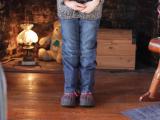
Pull on your boots so they overlap your long johns. Lace up your boots comfortably loose. Tightly laced boots will make your feet cold. Once laced, pull your jeans over your boots. If your boots are low-cut, make sure your jeans overlap the entire top of the boot including the tongue of the boot.
Now put on your scarf or Turtle Fur. If you are wearing a Turtle Fur, pull it over the collar of your sweater so that it overlaps the sweater collar and covers your neck up to your chin. Scarfs will also overlap your sweater collar and should NOT be tied as you would when going out for drinks. Instead place the scarf around the back of your neck overlapping your sweater collar, hanging down your front side. Hold the left side of the scarf in the middle of your neck so it drapes down your front like a neck tie, then take the right end and toss over your left shoulder, down your back while assuring that there are no twists. Put on your hat so that the back of your hat lightly overlaps your scarf or Turtle Fur.
Jacket time! Put on your jacket, assuring that your scarf ends stay inside the jacket. The scarf end that is draped in front should be draped down the center of your chest like a neck tie. Zip up your jacket while assuring that nothing is getting tight. When putting on your gloves, make sure your jacket sleeves are loose. Gloves will go up your wrists, overlapping your sweater or thermal shirt. This depends on how loose the gloves are and how loose your sweater is. Now pull your jacket sleeves over the gloves. No skin should be accessible!
A hood on your jacket or parka will make a huge difference if wind chill is a factor. A good wool hat will not keep out the wind. Many jacket hoods have a faux fur lining that will add a significant amount of protection from the wind. Though a hood is not essential, it is a huge bonus!
Now that you are all dressed, you will notice that you really do not look bulky and are actually looking quite stylish, unless your parka is hot pink or safety orange. Lack of excessive bulkiness is a good marker of properly dressing for a winter night out.
Some closing notes and tips. Even with good boots and good socks the soles of your feet eventually get cold after hours of standing on cold ground. There are a few tricks you can do to address this issue. The first solution is to use insole foot warmers. They are made by Hot Hands and sit in between the sole of your foot and the sole of your boot. The will offer about 6 hours of good warmth before giving up. If using this option, be sure that you are not making your boot fit too tight, otherwise the insert will be useless. Another potential option is to integrate battery powered, heated socks. We have not used these and there are concerns about the battery pack creating a pressure point. Perhaps over the next year or so we will give these a try and update this section.
When you are out and about in the cold, do not stand in a stiff manner. I see visitors doing this all the time, it will just make you colder. The best thing you can do to warm up is to remain relaxed and move around inside your clothes. By moving around inside your clothes, you will allow better movement of heat, as well as enable blood flow towards your extremities.
A fantastic trick for cold hands, though weird and uncomfortable, is as follows:
1: Place your arms to your sides.
2: With your arms at your sides, bend your wrists lifting your hands outward in a fashion where the top of your hands are perpendicular to your side.
3: With your hands in that position, shrug your shoulders HARD while keeping your elbows locked straight, and hold for 10 seconds.
4: With your hands still in that position and your elbows still locked, thrust your arms downward, with force, from the shrug.
5: Loosen your arms, elbows, shoulders, and hands. In a relaxed method, and with your hands hanging at your side, shake out your hands for about 30 seconds while moving your fingers calmly.
6: Repeat the process one more time.
It's ridiculous to read, and even more to do it. Those around you will certainly give you the concerned look. Regardless of how silly you look / feel, you will be surprised at how fast your hands will warm up.
Now get out there and have a fun fantastic night under the stars and take comfort in knowing you will stay nice and toasty warm!
- Author:
- Scott MacNeill
- Entry Date:
- Jan 24, 2025
- Published Under:
- Scott MacNeill's Columns

